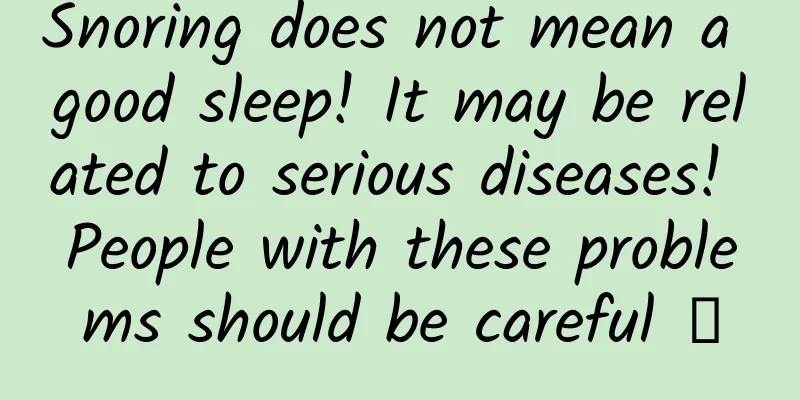Snoring does not mean a good sleep! It may be related to serious diseases! People with these problems should be careful →

|
Snoring is a very common phenomenon among people, and almost everyone has experienced snoring. Many people think that snoring means they sleep well, so they don't care about long-term snoring. However, some people who snore for a long time or seriously may have health risks, and some have even developed complications without realizing the seriousness of the problem. For this group of people, they need to pay attention to the fact that snoring can cause a disease - obstructive sleep apnea (OSA). According to epidemiological surveys, there are about 176 million OSA patients in my country. In addition, snoring may also be a nuisance to the person next to you, and many families even sleep in separate rooms because of this. 01 How does snoring occur? There are many reasons for snoring. When the upper airway resistance increases, the soft tissues in the throat, such as the tongue root and soft palate, are in a relaxed state and collapse downward. When the airflow passes through the narrow part of the airway during breathing, the tissue vibrates and produces a sound called snoring. The narrower the airway, the stronger the airflow, the more obvious the tissue vibration, and the louder the snoring. However, not all snoring affects physical health. Some people just snore, but their sleep structure is good and there is no hypoxia, so it does not affect their health. When the upper airway resistance is too great, the airway becomes narrower during inhalation, or even completely blocked, and airflow cannot pass through the airway smoothly (just like the water flow becomes thinner or even stops when a water pipe is blocked), resulting in a decrease in the oxygen content in the blood. The brain senses this state and wakes us up from sleep to reopen the airway for breathing. This awakening time is usually so short that we don't even remember it. This pattern can occur intermittently many times, or even last all night. This state is called obstructive sleep apnea (OSA). If long-term snoring develops OSA, it may directly or indirectly lead to serious, multi-system health problems. 02 What are the symptoms? Daytime sleepiness and fatigue: This is a very common symptom that is easily ignored. Fatigue, sleepiness, lack of concentration, and temper tantrum often occur when reading, attending meetings, driving, etc. Sometimes the person does not notice it, but only seeks medical attention after being discovered by his family, which can lead to reduced work efficiency and quality of life. In severe cases, it may lead to traffic accidents and endanger life. Respiratory interruption: usually discovered by family members, there is a period of silence during snoring, or even breathing interruption, but breathing will resume with loud snoring, and sometimes the person will wake up due to suffocation; Morning headache: About 10% to 30% of OSA patients experience headache symptoms within a few hours of waking up in the morning. Sore throat or discomfort in the morning: After a night of throat soft tissue vibration and mouth breathing, many people experience sore throat and discomfort in the morning. Slow growth and development: Common in children 03 Cardiovascular system diseases What needs everyone's attention is that more and more studies have shown that OSA is associated with many cardiovascular complications, including hypertension, atrial fibrillation, heart failure, coronary artery disease, stroke (cerebral infarction), pulmonary hypertension, and severe OSA is associated with cardiovascular mortality. Mechanisms affecting cardiovascular disease Source: Reference [4] Additionally, OSA is a condition with potential negative feedback, i.e., OSA → hypertension → worsening OSA, thus entering a vicious cycle. 04 What are the risk factors? Can it easily cause or aggravate OSA? Age: The incidence rate increases with age. The elderly are a high-risk group. In my country, there are more and more elderly people, and the number of people snoring is very large. Gender: The incidence rate in men is 2 to 3 times that in women, and the risk in postmenopausal women is close to that in men; Obesity: BMI (body mass index) is an indicator closely related to OSA risk and is the main cause of many snoring patients. Fat accumulation in the upper airway will further narrow the airway. The above three factors are relatively clear risk factors that can cause OSA. The following are risk factors that may aggravate OSA: Smoking: Smoking increases upper airway inflammation. Smokers are nearly three times more likely to develop OSA than non-smokers. Drinking alcohol or taking sedatives: This can cause the soft tissues in the throat to relax excessively during sleep, aggravating snoring symptoms Abnormalities in the craniofacial and upper airway anatomy: From the anterior nares to the larynx, any anatomical factor that causes airway narrowing on any plane may increase the risk of OSA. If the airway is likened to a water pipe, any narrow part of the pipe will reduce the water flow and make it more prone to dehydration, such as large neck circumference, retruded mandible, small mandible, enlarged tongue, enlarged uvula and soft palate, enlarged tonsils and adenoids (common in children), deviated nasal septum, sinusitis, etc. Genetics: OSA has a certain degree of familial clustering. When a family member suffers from OSA, the risk of developing the disease may increase. However, it should be noted that many parents think that children's snoring is caused by genetics and do not pay attention to it. In fact, children's snoring needs to focus on whether there are problems with enlarged tonsils or adenoids. 05 When should I see a doctor? How is it diagnosed? If the above clinical symptoms occur, or if there are related cardiovascular and cerebrovascular complications, especially for people with high-risk factors, it is recommended to go to the hospital as soon as possible. In addition to a detailed medical history and physical examination, the doctor may ask you to do some related tests. Among them, sleep monitoring is a test that can evaluate the frequency of respiratory events and the degree of blood oxygen decline during sleep throughout the night. It can obtain a relatively objective, intuitive and quantitative sleep result, which is very meaningful for guiding treatment. The gold standard for diagnosing OSA is polysomnography (PSG) under the supervision of technicians, which requires one night's stay in a hospital sleep center. However, many hospitals do not have the conditions, and many people are unwilling to stay overnight in the hospital. In this case, based on the conditions of the local hospital and one's own wishes, one can choose a portable sleep monitor to take home. The accuracy and completeness of this equipment are not as high as PSG, but it still has guiding significance for treatment. 06 How to treat it? OSA is a chronic disease that requires long-term, multidisciplinary management. It cannot be cured once and for all by taking a certain medicine or applying a certain patch. Early diagnosis, early treatment, and long-term treatment can bring more benefits, including improving clinical symptoms (such as reducing daytime sleepiness), reducing future medical-related expenses, and possibly reducing the incidence and mortality of cardiovascular complications. The following are some common treatments and auxiliary treatments: 1. Wearing a ventilator: Once OSA is diagnosed, the first-line treatment is to wear a ventilator and perform positive pressure ventilation therapy (such as continuous positive airway pressure, CPAP). External pressure is used to help open blocked airways and meet oxygen supply during sleep at night. It can reduce the frequency of respiratory events during sleep, reduce daytime sleepiness, improve blood pressure, reduce the risk of car crashes, improve erectile dysfunction and improve the quality of life. In clinical practice, I often encounter such situations. When I recommend wearing a ventilator, many patients, even friends, are very reluctant to use it. It may be because they don't know much about it, but I still strongly recommend that you try it. You can provide more and more patient health education. If you can't tolerate it after using it, you can consider other treatment options. 2. Oral braces: It is an alternative treatment for OSA. It can be used for patients with mild to moderate OSA who refuse or cannot tolerate positive airway pressure therapy. It is usually evaluated and treated in the dental department. Oral braces can protrude the mandible and enlarge the pharyngeal cavity, thereby preventing the upper airway from collapsing during sleep. 3. Behavior correction: It is recommended to be taken as a daily life precaution and long-term management matter. Lose weight, control diet, and increase exercise, which are extremely cost-effective treatment methods; ban smoking and drinking; patients with positional OSA should adopt a side-lying position as much as possible. 4. Surgical treatment: Patients who refuse positive airway pressure or oral appliance treatment or have tried these treatments and have no effect, and patients with obvious structural abnormalities such as tonsillar hypertrophy or nasal septum deviation may be considered for surgical treatment. References: [1] Expert consensus on screening and management of high-risk groups for obstructive sleep apnea in adults [2] UpToDate [3]Mayoclinic [4]Obstructive Sleep Apnea and Cardiovascular Disease: A Scientific Statement From the American Heart Association Produced by | Science Popularization China Author: Li Huimin, Department of Otolaryngology, Zhuozheng Medical Review | Chen Gang, Chief Physician, Beijing Friendship Hospital, Capital Medical University |
<<: Why do humans wipe their butts after defecation, but animals don't?
Recommend
Will milk tea be classified into nutritional levels? Which level of milk tea is healthy?
According to recent media reports, Shanghai has p...
14 famous brands of oyster sauce, you will know which one to choose after reading this!
A delicious life is inseparable from seasonings. ...
Musk claims Tesla batteries are 100% recyclable, but experts refute it; electric vehicles still pose environmental risks
Whether electric cars are more environmentally fr...
To give giraffes “manicures”, you have to start when they are babies!
In the previous sharing, we discussed in detail t...
Yueqianli.com's foundation course, where beginners can open up their own money-making channels in seven days
Yueqianli.com foundation course, a beginner can o...
Will the parallel lines of sadness ever meet one day?
When it comes to parallel lines, everyone is fami...
If you want to understand the third online audio-visual conference, these points are indispensable
On December 3, the "3rd China Online Audiovi...
Don’t wear these colors of swimsuits when swimming in summer, it’s really dangerous!
Summer is here, and many people may be eager to j...
What's the next step for smart home? Convincing consumers is the key
Do you use Nest to control your oven? Is your car...
8 sets of information flow advertising ideas + 2 types of combination targeting, Get it! | Gaming Industry
Among Baidu's information flow resources, Bai...
How do WeChat Mini Programs generally charge? How do WeChat Mini Programs charge?
With the explosion of mini programs, many custome...
Interpretation of iResearch's 2014 DSP Industry Analysis Report
iResearch recently released the "2014 DSP In...
Today is the Great Heat丨The Great Heat is approaching, the forest bell is moving to the ninth summer
Today (23rd) 4:07 Welcome the "Great Heat&qu...
How to use seed users to drive brand promotion growth?
Many brand companies have realized that to carry ...
New policy on subsidies for rural veterans turning 60 in 2022: How much per month?
In order to protect the quality of life of vetera...









